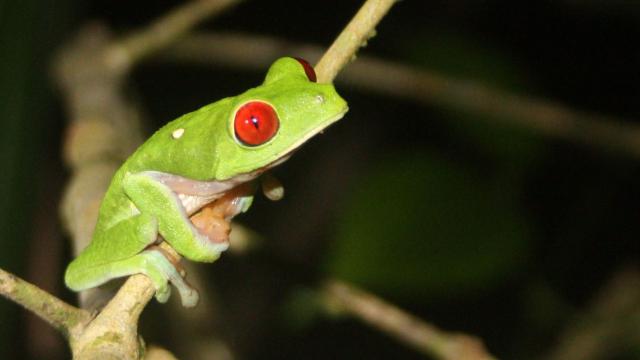Frogs have been around for nearly 200 million years, but it wasn’t until a 16km-wide asteroid struck our planet, wiping out three-quarters of all life on Earth — including the dinosaurs — that these crafty amphibians were able to make their big evolutionary move, according to new research.
Red-eyed tree frog (Wikimedia)
A study published in Proceedings of the National Academy of Sciences this week shows that frog populations exploded after the Cretaceous-Paleogene extinction event some 66 million years ago. The sudden disappearance of the dinosaurs, followed by the re-emergence of abandoned ecosystems, allowed frogs to flourish and diversify, leading to the thousands of species that still inhabit our planet.
Mass extinction events are like giant reset buttons. When a large asteroid struck the Yucatan Peninsula some 66 million years ago, it set off a chain of geologic and atmospheric events that wiped out 75 per cent of life on Earth, including nearly every animal larger than 25kg (except some turtles and crocodiles). With the giant lizards suddenly gone, and as the environment slowly healed itself, the survivors jockeyed for position within the re-emerging ecosystems. New research from the Florida Museum of Natural History and Sun Yat-Sen University in Guangzhou, China, shows that frogs were among the greatest beneficiaries of the transition from the Late Cretaceous to the post-dinosaur Paleogene.
In an effort to learn more about frog evolution, researchers David Blackburn and Peng Zhang put together a new phylogenetic tree of these amphibians (phylogenetic trees are like family trees, but at the species level, and driven by genetic data). The researchers looked at 95 genes from the DNA of 156 frog species to establish genetic relationships and develop evolutionary timelines.
Contrary to conventional thinking, Blackburn and Zhang found that most modern frog families didn’t originate during the Mesozoic era — that vast expanse of time during which the dinosaurs reigned. Frogs first emerged hundreds of millions of years ago, but it wasn’t until after the demise of the dinosaurs that their populations really took off. With their lizard cousins gone, frogs became among the most diverse groups of vertebrates, accounting for more than 6700 known species. As the new research shows, 88 per cent of frog species are descended from three main lineages — hyloidea, microhylidae and the natatanura — that emerged during the transition from the Cretaceous to the Paleogene.
Repressed for millions of years, these wily amphibians were suddenly able to occupy and thrive within vacant ecological niches. The asteroid that struck the Earth, and ensuing environmental changes, destroyed a significant fraction of our planet’s vegetation, but as forests recovered, frogs were one of the many animals groups (mammals included) that were able to take advantage of the new habitats.
[referenced url=”https://gizmodo.com.au/2016/09/the-sixth-mass-extinction-will-be-like-nothing-in-earths-history/” thumb=”https://i.kinja-img.com/gawker-media/image/upload/t_ku-large/jdd2xhi4mrfbtw6aprx5.jpg” title=”The Sixth Mass Extinction Will Be Like Nothing In Earth’s History” excerpt=”The sixth mass extinction — the one that seven billion humans are doing their darnedest to trigger at this very moment — is shaping up to be like nothing our planet has ever seen. That’s the conclusion of a sweeping new analysis, which compared marine fossil records from Earth’s five previous mass extinction events to what’s happening in the oceans right now.”]
Sadly, we are in the midst of another mass extinction event, one of our own making. Frogs are threatened like never before, owing to habitat loss, pollution, disease and other factors. According to the IUCN, nearly one-third of the world’s amphibians are now threatened or have recently become extinct. Frogs managed to survive the dinosaur era, but they’re having a hell of time dealing with us humans.
